Elisa Rolle's Blog, page 323
January 6, 2016
Blog Tour: Three To Get Ready by Sean Michael
 Three To Get Ready (Mannies Incorporated 4) by Sean Michael
Three To Get Ready (Mannies Incorporated 4) by Sean MichaelPublisher: Sean Michael (December 13, 2015)
Amazon Kindle: Three To Get Ready (Mannies Incorporated 4)
Blurb: Single father Jack Jones is in dire need of a new nanny. His five year old son Nathan is legally blind, he has twin baby girls arriving in less than two months and the girl currently working for him is leaving at Thanksgiving to go home and continue her higher education. If Mannies Incorporated doesn’t come up with a viable candidate soon, he’s not sure what he’s going to do.
Dan Miller is on the hunt for a new job. He’s had some great placements with Mannies Incorporated, many as Manny to multiple birth families to get them over the hump. He even has experience with special needs children, so the job he’s interviewing for looks like it’s right up his alley.
When Dan arrives at Jack’s house, he discovers that this Jack Jones is his Jack Jones, the man he was in love with during college, and who broke up with Dan because Dan wanted children. Will Dan and Jack be able to put the past behind them and work together, or will their past keep them from having a future together?
( Excerpt )

 Meet the author: Often referred to as "Space Cowboy" and "Gangsta of Love" while still striving for the moniker of "Maurice," Sean Michael spends his days surfing, smutting, organizing his immense gourd collection and fantasizing about one day retiring on a small secluded island peopled entirely by horseshoe crabs. While collecting vast amounts of vintage gay pulp novels and mood rings, Sean whiles away the hours between dropping the f-bomb and pursuing the kama sutra by channeling the long lost spirit of John Wayne and singing along with the soundtrack to "Chicago."
Meet the author: Often referred to as "Space Cowboy" and "Gangsta of Love" while still striving for the moniker of "Maurice," Sean Michael spends his days surfing, smutting, organizing his immense gourd collection and fantasizing about one day retiring on a small secluded island peopled entirely by horseshoe crabs. While collecting vast amounts of vintage gay pulp novels and mood rings, Sean whiles away the hours between dropping the f-bomb and pursuing the kama sutra by channeling the long lost spirit of John Wayne and singing along with the soundtrack to "Chicago."A long-time writer of complicated haiku, currently Sean is attempting to learn the advanced arts of plate spinning and soap carving sex toys.
Barring any of that? He'll stick with writing his stories, thanks, and rubbing pretty bodies together to see if they spark.
1) What’s the easiest thing about writing?
The actual writing part. I love writing. It is the best thing in the world. I love listening to the characters who live in my head as they tell me their story. It makes me happy. And I love that there are readers for what I write. That also makes me happy.
2) Name one author (living or dead) you’d like to write with?
I would love to write with William Shakespeare. Hell, just watching his process would be fun. He was very ribald and earthy and I think he would get a kick out of the explicit works available these days.
3) Tell us about your cover and how it came about.
The amazing Kris Norris did the cover for Three to Get Ready and I think she did a fabulous job. I told Kris what the book was about, who the characters were and what was important for the cover, then Kris sent back a sample and I was pleased with how my ideas were interpreted and made better. And I’m very happy with the final result.
I also needed a new logo for the series and I was so happy with the one that Kris came up with that I wound up asking for the logo so I could put it on t-shirts, ball caps, tote bags…
4) Is this book part of a series? Do you have ideas that could make it into a series? If it is a series, tell us a little about it.
Three to Get Ready is a part of the Mannies Incorporated series. The books can actually all be read as stand alones, but each one features a manny who the family needing the help has procured through the Mannies Incorporated company, which was formed by the two men who stared in the original book.
I have lots of ideas to continue the series and hope to be able to write one a year.
5) Word association. Tell us the first thing that comes to mind when you read these words.
Ketchup – French fries
Flakes – snow!
Elastic -- band
Timer -- cooking
Google - research
Thank you again for having me. A happy 2016 to everyone!
Where to find the author:
Facebook: https://www.facebook.com/profile.php?...
Facebook Author Page: https://www.facebook.com/SeanMichaelW...
Twitter: seanmichael09
Website www.seanmichaelwrites.com
Blog http://seanmichaelwrites.blogspot.com/
Goodreads Link: https://www.goodreads.com/author/show...

( Tour Dates & Stops )
Giveaway:
Rafflecopter Prize: E-copy of ‘Three To Get Ready’ by Sean Michael
Rafflecopter Code:
a Rafflecopter giveaway

 comments
comments
Published on January 06, 2016 01:20
January 5, 2016
Queer Places: Camposanto Monumentale, Pisa
Address: Il Camposanto
Piazza del Duomo,
Pisa PI
Italy
The Campo Santo, also known as Camposanto Monumentale ("monumental cemetery") or Camposanto Vecchio ("old cemetery"), is a historical edifice at the northern edge of the Cathedral Square in Pisa, Italy.
"Campo Santo" can be literally translated as "holy field", because it is said to have been built around a shipload of sacred soil from Golgotha, brought back to Pisa from the Fourth Crusade by Ubaldo de' Lanfranchi, archbishop of Pisa in the 12th century. A legend claims that bodies buried in that ground will rot in just 24 hours. The burial ground lies over the ruins of the old baptistery of the church of Santa Reparata, the church that once stood where the cathedral now stands.
The term "monumental" serves to differentiate it from the later-established urban cemetery in Pisa.
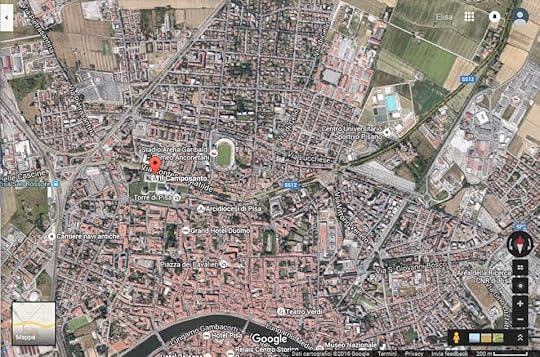
The outer wall is composed of 43 blind arches. There are two doorways. The one on the right is crowned by a gracious Gothic tabernacle. It contains the Virgin Mary with Child, surrounded by four saints. It is the work from the second half of the 14th century by a follower of Giovanni Pisano. This was the original entrance door. Most of the tombs are under the arcades, although a few are on the central lawn. The inner court is surrounded by elaborate round arches with slender mullions and plurilobed tracery.
The cemetery has three chapels. The oldest ones are the chapel Ammannati (1360) and takes its name from the tomb of Ligo Ammannati, a teacher in the University of Pisa; and the chapel Aulla, were there is an altar made by Giovanni della Robbia in 1518. In the Aulla chapel we can see also the original incense lamp that Galileo Galilei used for calculation of pendular movements. This lamp is the one Galileo saw inside the cathedral, now replaced by a larger more elaborate one. The last chapel was Dal Pozzo, commissioned by archbishop of Pisa Carlo Antonio Dal Pozzo in 1594; it has an altar dedicated to St. Jerome and a little dome. In this chapel in 2009 were translated the relics of the Cathedral: the relics include among the others eleven of the twelve Apostles, two fragments of the True Cross, a thorn from the Crown of Thorns of Christ and a small piece of the dress of the Virgin Mary. Also in the Dal Pozzo chapel sometimes a Mass is celebrated.
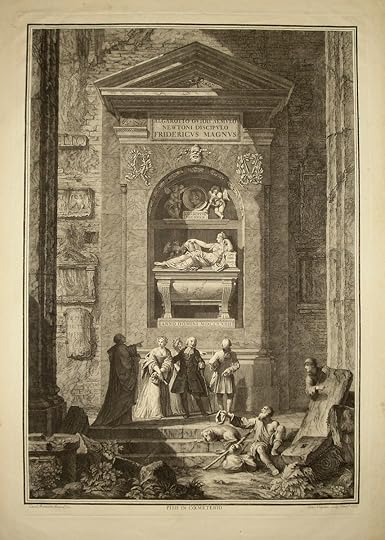
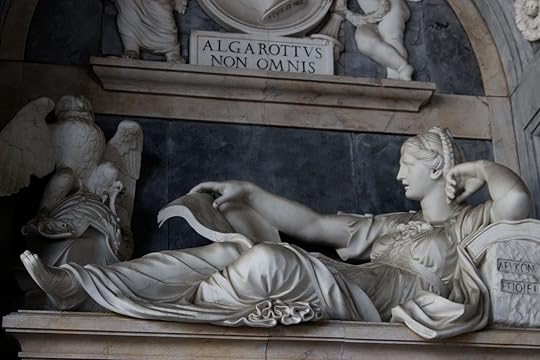
On the south wall, under the frescos by Taddeo Gaddi, there is to monument to Conte Francesco Algarotti (d. 1764) by Carlo Bianconi, Mauro Tesi e Giovanni Antonio Cibei. In 1762 Francesco Algarotti moved to Pisa, where he died of tuberculosis. Frederick the Great, one of his previous lovers, paid for a monument to his memory on the Camposanto of Pisa (Pisa's cemetery), still visible today.
( Francesco Algarotti's Life )
 comments
comments
Piazza del Duomo,
Pisa PI
Italy
The Campo Santo, also known as Camposanto Monumentale ("monumental cemetery") or Camposanto Vecchio ("old cemetery"), is a historical edifice at the northern edge of the Cathedral Square in Pisa, Italy.
"Campo Santo" can be literally translated as "holy field", because it is said to have been built around a shipload of sacred soil from Golgotha, brought back to Pisa from the Fourth Crusade by Ubaldo de' Lanfranchi, archbishop of Pisa in the 12th century. A legend claims that bodies buried in that ground will rot in just 24 hours. The burial ground lies over the ruins of the old baptistery of the church of Santa Reparata, the church that once stood where the cathedral now stands.
The term "monumental" serves to differentiate it from the later-established urban cemetery in Pisa.

The outer wall is composed of 43 blind arches. There are two doorways. The one on the right is crowned by a gracious Gothic tabernacle. It contains the Virgin Mary with Child, surrounded by four saints. It is the work from the second half of the 14th century by a follower of Giovanni Pisano. This was the original entrance door. Most of the tombs are under the arcades, although a few are on the central lawn. The inner court is surrounded by elaborate round arches with slender mullions and plurilobed tracery.
The cemetery has three chapels. The oldest ones are the chapel Ammannati (1360) and takes its name from the tomb of Ligo Ammannati, a teacher in the University of Pisa; and the chapel Aulla, were there is an altar made by Giovanni della Robbia in 1518. In the Aulla chapel we can see also the original incense lamp that Galileo Galilei used for calculation of pendular movements. This lamp is the one Galileo saw inside the cathedral, now replaced by a larger more elaborate one. The last chapel was Dal Pozzo, commissioned by archbishop of Pisa Carlo Antonio Dal Pozzo in 1594; it has an altar dedicated to St. Jerome and a little dome. In this chapel in 2009 were translated the relics of the Cathedral: the relics include among the others eleven of the twelve Apostles, two fragments of the True Cross, a thorn from the Crown of Thorns of Christ and a small piece of the dress of the Virgin Mary. Also in the Dal Pozzo chapel sometimes a Mass is celebrated.


On the south wall, under the frescos by Taddeo Gaddi, there is to monument to Conte Francesco Algarotti (d. 1764) by Carlo Bianconi, Mauro Tesi e Giovanni Antonio Cibei. In 1762 Francesco Algarotti moved to Pisa, where he died of tuberculosis. Frederick the Great, one of his previous lovers, paid for a monument to his memory on the Camposanto of Pisa (Pisa's cemetery), still visible today.
( Francesco Algarotti's Life )
 comments
comments
Published on January 05, 2016 01:54
Blog Tour: The Boys of Summer by Sarah Madison
 The Boys of Summer by Sarah Madison
The Boys of Summer by Sarah MadisonPaperback: 200 pages
Publisher: Dreamspinner Press; 2nd edition (December 21, 2015)
Language: English
ISBN-10: 1634766717
ISBN-13: 978-1634766715
Amazon: The Boys of Summer
Amazon Kindle: The Boys of Summer
Blurb: 2nd Edition
David McIntyre has been enjoying the heck out of his current assignment: touring the Hawaiian Islands in search of the ideal shooting locations for a series of film-company projects. What’s not to like? Stunning scenery, great food, sunny beaches… and Rick Sutton, the hot, ex-Air Force pilot who is flying him around.
Everything changes when a tropical storm and engine failure force a crash landing on a deserted atoll with a WWII listening post. Rick’s injuries and a lack of food and water mean David has to step up to the plate and play hero. While his days are spent fighting for survival, and his nights are filled with worrying about Rick, the two men grow closer. David’s research for his next movie becomes intertwined with his worst fears, and events on the island result in a vivid dream about the Battle of Britain. On waking, David realizes Rick is more than just a pilot to him. The obstacles that prevented a happy ending in 1940 aren’t present today, and David vows that if they survive this stranding, he will tell Rick how he feels.
( Excerpt )

About the Author: Sarah Madison is a veterinarian with a large dog, an even bigger horse, too many cats, and a very patient boyfriend. An amateur photographer and a former competitor in the horse sport known as eventing, when she's not out hiking with the dog or down at the stables, she's at the laptop working on her next story. When she’s in the middle of a chapter, she relies on the smoke detector to tell her dinner is ready. She writes because it’s cheaper than therapy.
Sarah Madison was a finalist in the 2013 Rainbow Awards and is the winner of Best M/M Romance in the 2013 PRG Reviewer’s Choice Awards.
If you want to make her day, e-mail her and tell you how much you like her stories.
"Some time ago, I wrote a blog post I’m quite proud of, titled Ten Things I Wish Someone Had Told Me as a Newbie Author. I thought it was a good post, and I thought it had some great quotes and resources. As always when you write something like this however, you can always think of something more you wished you’d added. In this case, the thing I wish I’d mentioned was the difference between being yourself and over-sharing online.
This struck home the other day when I read a post about professionalism and being taken seriously as an author. The truth was staring me right there in the face. Yep, you got it, I overshare.
I think this is part because I have always been a person who is better at communicating on paper than in person. I could also lay the blame to the fact that came from a fanfiction background, and journaling anonymously was part fandom participation at the time. I certainly have an over-inflated idea of the security of any online persona. Then too, there’s the notion we’re all supposed to ‘be ourselves’ and share little bits of our lives with our readers and fans. And let’s not forget that many of us feel closer to our online friends than our ‘real life’ ones. We’re all so busy, and it is so hard to make schedules match for a good old-fashion gab-fest with our friends. But we can always post something on Facebook, or Twitter, or our website and be reasonably assured of a response.
Well, let me tell you, there’s a fine line between sharing and over-sharing.
You have adorable dogs or cats? Post their pictures. People love sharing pictures of cute animals and talking about the funny things they’ve done. It’s a great way to start a conversation or to bring people to your blog—to check out the latest adventures of your pets.
You live in an unusual location or maintain an offbeat lifestyle? People love reading about a way of life that’s different from theirs. Share your alpaca farming anecdotes, or your pictures from the sci-fi convention. You’re a big Doctor Who fan? Talk about it. No worries there. Yes, this is a part of the authentic you that you can easily share.
You have interesting hobbies? Maybe you’re a snowboarder or a photographer in your spare time. Maybe you knit, or bake, or rock climb, or gallop horses over big fences. Share. Other people will find you through shared interests, or simply enjoy reading about something they find cool but know they would never do themselves. Heck, post about your ‘thing’ on a regular basis and draw in readers with the same interests. It’s all good.
Where it gets tricky is when you move out of the global you and into the more personal you. Health or financial crises. Relationship woes. Struggles with depression or illness. There are bloggers and personalities that have helped a large number of people by sharing their own battle with these things, and I’ve definitely noticed that posts on these subjects frequently get more comments than any other, but you’re entering a grey zone here. You don’t want to be known as ‘that writer with that problem’. J.K. Rowling can say that the Dementors are her metaphor for depression, and admit she’s struggled with it, but that’s not the same as writing posts about your struggle all the time. Believe me, I know how hard this one is. In part because that whole commenting thing is bloody addictive. That is the real reason we walk around with our eyes glued to our phones. I bet every time a comment on something we’ve posted lands in our inbox, the cocaine/whiskey/sex center lights up in our brains. It’s why we do it. It’s why we post things we know in our hearts we probably shouldn’t, especially if we want to be taken seriously as a writer.
Sometimes it’s hard not to post about things that make us angry. The state of politics in the US at the moment makes me froth with rage on a good day. I’m doing my best not to add fuel to the fire, but sometimes we should be outraged and we should speak our minds. Some of the most powerful, best essays I’ve ever read were born out of this kind of reaction. But again, you don’t want to be known as that writer who’s always going off about politics—unless, of course, that’s what you write!
There are levels of ‘being yourself’, you know. We practice this all the time with the people in our lives. There are things we choose not to share with our parents versus our friends. There are thoughts and opinions we might sit tight on when talking with our bosses or our pastor versus our neighbor or our siblings. The problem comes when we post something online, we aren’t sure who might be in that audience at any given time. I tend to share too much because I believe in authenticity. But when it comes to your brand as a writer, you have to remember what you want to be remembered for before you click ‘send’."
|| Facebook || Facebook Page || Twitter || Website & Blog || Pinterest || Tumblr ||
Giveaway:Winner’s Prize: E-copy of The Boys of Summer
Rafflecopter Code:
a Rafflecopter giveaway
Rafflecopter Link: http://www.rafflecopter.com/rafl/disp...?
( Tour Schedule )

 comments
comments
Published on January 05, 2016 01:36
January 4, 2016
Queer Places: Melbury House and the Parish Church of St. Mary
Address: Melbury Sampford is a small parish 8 m. S.S.W. of Sherborne. Melbury House and the church are both monuments of importance.
Melbury House in Melbury Sampford near Evershot, Dorset, has been the seat of the Strangways family of Dorset since the estate was sold in 1500 by William Bruning to Henry Strangways. Parish Church of St. Mary stands 50 yards E. of the house. The present house was rebuilt after 1546 by his son, Sir Giles Strangways (died 1562), using ham stone from a quarry nine miles away. Though Sir Giles lived extravagantly and encumbered his considerable estate with debts at his premature death, at Melbury he built a conservative house, "a courtyard with no frills", as Mark Girouard described it, "apart from the one gesture of its tower". This remarkable feature, a hexagonal tower, rises near the intersection of three ranges of buildings, filled above the level of adjoining roofbeams with banks of tall arched windows of many leaded panes that offer views in every direction over the rolling landscape of the park and the countryside beyond. Its roof has mock battlements.

It was altered and extended in 1692 by Thomas Strangways, under the direction of Watson, a local mason-builder who is probably to be identified with John Watson of Glashampton, Gloucestershire. It was further modernized in the 19th century.
The house has remained in the same family, passed from the Strangways heiress to Stephen Fox-Strangways, 1st Earl of Ilchester, who took the additional name of Strangways in right of his wife's mother's mother. When Horace Walpole visited Melbury, he admired the paintings and tapestries in "apartments most richly and abundantly furnished".
Stephen Fox was the lover of Lord Hervey (http://reviews-and-ramblings.dreamwid...) for a period of ten years, from 1726 to 1736. There exist many passionate letters between the two ("The Gay Love Letters of John, Lord Hervey to Stephen Fox"; excerpts from My Dear Boy: Gay Love Letters through the Centuries (1998), edited by Rictor Norton). Hervey initially favoured Stephen's brother, Henry Fox, but when charmingly rebuffed paid infatuated court to Stephen. His relationship with Lord Hervey ended only when a marriage was arranged with thirteen-year-old Elizabeth Horner, daughter of Thomas Strangways Horner and Susanna Strangways, in 1735.

Melbury House has evolved over the centuries from a simple medieval country manor house of the former village of Melbury Sampford, to the imposing building that stands here today (of which just a small part is visible). Its unique hexagonal tower, and the multi-gabled mansion that lies behind this view of the entrance front, can only be glimpsed further along the public footpath that runs through the park. The house has as its backdrop a magnificent park landscaped by Capability Brown that contains many superb tree specimens, deer, and a lake. Owned by the Strangeways family and their descendants, one of whom was created Lord Ilchester in 1741, the park and its estate is known collectively today as the Ilchester Estates, and continues under the ownership of a Strangeways family descendant.
Not long after marrying, while recovering his health in Bath in 1726, Lord Hervey began courting Stephen Fox, a young country gentleman, and then visited his estate in Somerset. Hervey was thirty-one, Stephen twenty-three. The men spent so much time together that Lady Hervey protested that her estate at Ickworth had become "my hermitage." For fifteen months during 1728–9 Hervey and Stephen travelled Europe together on their Grand Tour. Exactly how close the two men became on that trip may be indicated by the fact that the first twenty-six pages of Hervey's volume of letters covering that period were torn out and destroyed by his grandson the first Marquess of Bristol. On their return from the Continent, Hervey could not stand the separation: "I must see you soon; I can't live without You" (November 15, 1729). In August 1730 Hervey proposed that they live together: "why should we see one another by Visits, but never have a common home?" He arranged for Lord Bateman to lend his house in Windsor to Stephen so that they could see one another while Hervey was engaged in his courtly duties at Windsor Castle; the Earl of Sunderland had arranged for his daughter to marry Bateman, but he was forced to separate from her when his homosexual tastes became too public. In November Hervey signed over the lease of his house on Great Burlington Street to Stephen, so they did achieve a common home even though technically Hervey moved into an apartment in St James's Palace. The letters had reached their peak of intensity in late September 1730, when Hervey tells Stephen that it is impossible "had I time to write volumes, how warmly, how tenderly, how gratefully, how contentedly and unalterably I am Yours" (September 24), and that "Every Body has some Madness in their Composition, & I freely acknowledge you are mine" (September 25). Hervey and Stephen spent the next two months together. The letters now conclude with frank avowals of love: "Adieu, que je vous aime, que je vous adore: & si vous m'aimé de même venez me le dire" (September 25). The Earl of Ilchester, who edited the letters in 1950, cut out the frequent avowals of devotion. Hervey regularly closes with Mon cher, et trés cher, carissime; caro et carissimo, et sempre caro; mea cara et sola voluptas; le plus aimable et le plus aimé qu'il y est au monde. In August 1731, at a large dinner party in the presence of the Prince of Wales, the Lord Chancellor drank to Stephen's health, and Hervey told Stephen that "without the least affectation, I assure you, I colour'd and felt just as I imagine your favorite & fondest Mistress would have done upon the same Occasion." But Hervey was sophisticated and urbane, and Stephen felt himself to be provincial; in November 1733 he told Hervey he was unfit to keep him company and planned to live alone in the country, at which Hervey protested "I should like you rusty better than any other body polish'd," but their correspondence more or less ceased by the end of that year. Hervey was appointed Vice-Chamberlain, i.e. master of court ceremonies, in 1730, and acted as a political propagandist under Walpole's ministry. He was frequently attacked by his enemies as a homosexual, e.g. an anonymous lampoon notes of his attendance at Parliament that he is "Lady of the Lords," and it was rumoured that he was the "pathick" of Frederick Prince of Wales, son of George II. They were undoubtedly close to one another (in later life they shared a mistress), and Stephen was jealous. Hervey arranged for Stephen's marriage to a child-heiress in 1736, and turned his attentions to Francesco Algarotti, the young Italian scholar who had taken London by storm that year. Another series of billets doux ensued between the two men, and Algarotti moved into Hervey's apartment at St James's in 1739. (Source: http://rictornorton.co.uk/hervey1.htm, Lord Hervey and His Friends 1726–38, ed. the Earl of ilchester (London: John Murray, 1950) and Robert Halsband, Lord Hervey: Eighteenth-Century courtier (Oxford: Clarendon Press, 1973).)
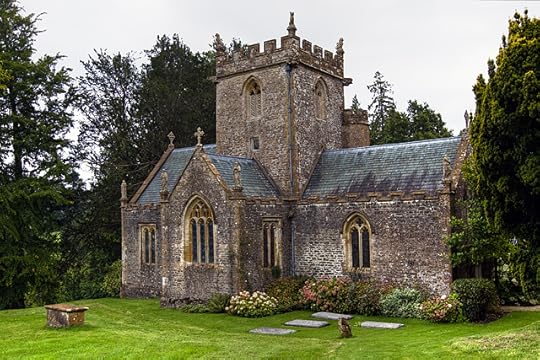
St Mary's Chapel, the former parish church of the lost village of Melbury Sampford lies close by within the grounds and to the southeast of Melbury House. The house Open Day also provided a rare chance to visit the church which is not normally accessible to the public. The building dates from the 15th century whose pinnacled tower decorated with heraldic beasts, guards the tombs beneath of the Brounings and Strangeways families.
In 1758, Lord Ilchester assumed the additional surname of Strangways. He died in September 1776 (buried in Melbury Sampford, the Parish Church of St. Mary, http://www.british-history.ac.uk/rchm...), aged 72, and was succeeded by his son Henry Thomas Fox-Strangways.
The pioneer of photography Henry Fox Talbot was born in the house. Thomas Hardy made use of Melbury House, as "King's Hintock Court", for passing mentions in "The Duke's Reappearance" in A Changed Man and Other Tales and in A Group of Noble Dames, 1891.
The house and its stable yard to the north are Grade I listed buildings. Melbury’s present owner, is Robin Fox-Strangways, 10th earl of Ilchester. He lives in rural Warwickshire and not, as the first seven of his predecessors had, at the Grade-I house which sits at the heart of the 15,000-acre Ilchester Estate.
( Strangways's genealogy )
 comments
comments
Melbury House in Melbury Sampford near Evershot, Dorset, has been the seat of the Strangways family of Dorset since the estate was sold in 1500 by William Bruning to Henry Strangways. Parish Church of St. Mary stands 50 yards E. of the house. The present house was rebuilt after 1546 by his son, Sir Giles Strangways (died 1562), using ham stone from a quarry nine miles away. Though Sir Giles lived extravagantly and encumbered his considerable estate with debts at his premature death, at Melbury he built a conservative house, "a courtyard with no frills", as Mark Girouard described it, "apart from the one gesture of its tower". This remarkable feature, a hexagonal tower, rises near the intersection of three ranges of buildings, filled above the level of adjoining roofbeams with banks of tall arched windows of many leaded panes that offer views in every direction over the rolling landscape of the park and the countryside beyond. Its roof has mock battlements.

It was altered and extended in 1692 by Thomas Strangways, under the direction of Watson, a local mason-builder who is probably to be identified with John Watson of Glashampton, Gloucestershire. It was further modernized in the 19th century.
The house has remained in the same family, passed from the Strangways heiress to Stephen Fox-Strangways, 1st Earl of Ilchester, who took the additional name of Strangways in right of his wife's mother's mother. When Horace Walpole visited Melbury, he admired the paintings and tapestries in "apartments most richly and abundantly furnished".
Stephen Fox was the lover of Lord Hervey (http://reviews-and-ramblings.dreamwid...) for a period of ten years, from 1726 to 1736. There exist many passionate letters between the two ("The Gay Love Letters of John, Lord Hervey to Stephen Fox"; excerpts from My Dear Boy: Gay Love Letters through the Centuries (1998), edited by Rictor Norton). Hervey initially favoured Stephen's brother, Henry Fox, but when charmingly rebuffed paid infatuated court to Stephen. His relationship with Lord Hervey ended only when a marriage was arranged with thirteen-year-old Elizabeth Horner, daughter of Thomas Strangways Horner and Susanna Strangways, in 1735.

Melbury House has evolved over the centuries from a simple medieval country manor house of the former village of Melbury Sampford, to the imposing building that stands here today (of which just a small part is visible). Its unique hexagonal tower, and the multi-gabled mansion that lies behind this view of the entrance front, can only be glimpsed further along the public footpath that runs through the park. The house has as its backdrop a magnificent park landscaped by Capability Brown that contains many superb tree specimens, deer, and a lake. Owned by the Strangeways family and their descendants, one of whom was created Lord Ilchester in 1741, the park and its estate is known collectively today as the Ilchester Estates, and continues under the ownership of a Strangeways family descendant.
Not long after marrying, while recovering his health in Bath in 1726, Lord Hervey began courting Stephen Fox, a young country gentleman, and then visited his estate in Somerset. Hervey was thirty-one, Stephen twenty-three. The men spent so much time together that Lady Hervey protested that her estate at Ickworth had become "my hermitage." For fifteen months during 1728–9 Hervey and Stephen travelled Europe together on their Grand Tour. Exactly how close the two men became on that trip may be indicated by the fact that the first twenty-six pages of Hervey's volume of letters covering that period were torn out and destroyed by his grandson the first Marquess of Bristol. On their return from the Continent, Hervey could not stand the separation: "I must see you soon; I can't live without You" (November 15, 1729). In August 1730 Hervey proposed that they live together: "why should we see one another by Visits, but never have a common home?" He arranged for Lord Bateman to lend his house in Windsor to Stephen so that they could see one another while Hervey was engaged in his courtly duties at Windsor Castle; the Earl of Sunderland had arranged for his daughter to marry Bateman, but he was forced to separate from her when his homosexual tastes became too public. In November Hervey signed over the lease of his house on Great Burlington Street to Stephen, so they did achieve a common home even though technically Hervey moved into an apartment in St James's Palace. The letters had reached their peak of intensity in late September 1730, when Hervey tells Stephen that it is impossible "had I time to write volumes, how warmly, how tenderly, how gratefully, how contentedly and unalterably I am Yours" (September 24), and that "Every Body has some Madness in their Composition, & I freely acknowledge you are mine" (September 25). Hervey and Stephen spent the next two months together. The letters now conclude with frank avowals of love: "Adieu, que je vous aime, que je vous adore: & si vous m'aimé de même venez me le dire" (September 25). The Earl of Ilchester, who edited the letters in 1950, cut out the frequent avowals of devotion. Hervey regularly closes with Mon cher, et trés cher, carissime; caro et carissimo, et sempre caro; mea cara et sola voluptas; le plus aimable et le plus aimé qu'il y est au monde. In August 1731, at a large dinner party in the presence of the Prince of Wales, the Lord Chancellor drank to Stephen's health, and Hervey told Stephen that "without the least affectation, I assure you, I colour'd and felt just as I imagine your favorite & fondest Mistress would have done upon the same Occasion." But Hervey was sophisticated and urbane, and Stephen felt himself to be provincial; in November 1733 he told Hervey he was unfit to keep him company and planned to live alone in the country, at which Hervey protested "I should like you rusty better than any other body polish'd," but their correspondence more or less ceased by the end of that year. Hervey was appointed Vice-Chamberlain, i.e. master of court ceremonies, in 1730, and acted as a political propagandist under Walpole's ministry. He was frequently attacked by his enemies as a homosexual, e.g. an anonymous lampoon notes of his attendance at Parliament that he is "Lady of the Lords," and it was rumoured that he was the "pathick" of Frederick Prince of Wales, son of George II. They were undoubtedly close to one another (in later life they shared a mistress), and Stephen was jealous. Hervey arranged for Stephen's marriage to a child-heiress in 1736, and turned his attentions to Francesco Algarotti, the young Italian scholar who had taken London by storm that year. Another series of billets doux ensued between the two men, and Algarotti moved into Hervey's apartment at St James's in 1739. (Source: http://rictornorton.co.uk/hervey1.htm, Lord Hervey and His Friends 1726–38, ed. the Earl of ilchester (London: John Murray, 1950) and Robert Halsband, Lord Hervey: Eighteenth-Century courtier (Oxford: Clarendon Press, 1973).)

St Mary's Chapel, the former parish church of the lost village of Melbury Sampford lies close by within the grounds and to the southeast of Melbury House. The house Open Day also provided a rare chance to visit the church which is not normally accessible to the public. The building dates from the 15th century whose pinnacled tower decorated with heraldic beasts, guards the tombs beneath of the Brounings and Strangeways families.
In 1758, Lord Ilchester assumed the additional surname of Strangways. He died in September 1776 (buried in Melbury Sampford, the Parish Church of St. Mary, http://www.british-history.ac.uk/rchm...), aged 72, and was succeeded by his son Henry Thomas Fox-Strangways.
The pioneer of photography Henry Fox Talbot was born in the house. Thomas Hardy made use of Melbury House, as "King's Hintock Court", for passing mentions in "The Duke's Reappearance" in A Changed Man and Other Tales and in A Group of Noble Dames, 1891.
The house and its stable yard to the north are Grade I listed buildings. Melbury’s present owner, is Robin Fox-Strangways, 10th earl of Ilchester. He lives in rural Warwickshire and not, as the first seven of his predecessors had, at the Grade-I house which sits at the heart of the 15,000-acre Ilchester Estate.
( Strangways's genealogy )
 comments
comments
Published on January 04, 2016 06:19
Book Blast: Blind Spot by Maggie Kavanagh
 Blind Spot (The Stonebridge Mysteries 3) by Maggie Kavanagh
Blind Spot (The Stonebridge Mysteries 3) by Maggie KavanaghPaperback: 206 pages
Publisher: Dreamspinner Press (January 4, 2016)
Language: English
ISBN-10: 1634767454
ISBN-13: 978-1634767453
Amazon: Blind Spot (The Stonebridge Mysteries 3)
Amazon Kindle: Blind Spot (The Stonebridge Mysteries 3)
Blurb: Living together is bliss for Sam Flynn and Nathan Walker, but things never stay quiet in Stonebridge for long. On the night of Sam’s twenty-ninth birthday, the much-hated mayor of Stonebridge is found dead at his home. Sam suspects foul play, but just as he starts investigating the list of possible culprits, Nathan gets word of a new undercover assignment—one that includes a mysterious, sexy new partner. Though Sam struggles to trust Nathan and control his jealousy during Nathan's absence, the stress makes a return to the bottle seem not only tempting, but inevitable—especially when Nathan starts avoiding his calls.
Yet Nathan's fidelity isn't the only thing on Sam's mind. A visit from the mayor's ex-assistant puts Sam in the line of fire, and he’s drawn into a complex web of duplicity spanning back to the night of his parents’ accident. Sam’s journey to uncover the truth about what really happened threatens to unravel long-held beliefs about his parents and puts his relationship with Nathan to the ultimate test.
( Excerpt )

 Meet the author: Maggie Kavanagh writes gay romances that explore flawed, human characters finding love. She went to graduate school for English literature and reads and writes voraciously, whenever she can steal a moment alone. You can find her in the wee morning hours typing away with coffee at hand and cat in lap, happily embodying the romance writer cliché.
Meet the author: Maggie Kavanagh writes gay romances that explore flawed, human characters finding love. She went to graduate school for English literature and reads and writes voraciously, whenever she can steal a moment alone. You can find her in the wee morning hours typing away with coffee at hand and cat in lap, happily embodying the romance writer cliché.While she focuses mainly on contemporary romance and mystery, don’t be surprised if a historical or supernatural tale slips into the mix, as she’s always eager to explore different genres. She lives in Southern California.
Where to find the author:
Facebook: https://www.facebook.com/maggie.kavan...
Twitter: https://twitter.com/maggie_kavanagh
Website: http://maggiekavanaghwrites.com/
Goodreads Link: https://www.goodreads.com/author/show...

Tour Dates & Stops: January 4, 2016
Parker Williams, The Hat Party, Happily Ever Chapter, Carly’s Book Reviews, Havan Fellows, Kirsty Loves Books, Bayou Book Junkie, Scattered Thoughts & Rogue Words, Book Reviews and More by Kathy, Book Lovers 4Ever, Sinfully Addicted to All Male Romance, BFD Book Blog, The Jena Wade, Wicked Faerie's Tales and Reviews, Louise Lyons, Elisa - My Reviews and Ramblings, Divine Magazine, Jessie G. Books, MM Good Book Reviews, Dawn’s Reading Nook, Inked Rainbow Reads, A.M. Leibowitz, My Fiction Nook, Velvet Panic
Rafflecopter Prize: Signed copies of the whole Stonebridge Mysteries series!
Rafflecopter Code:
a Rafflecopter giveaway

 comments
comments
Published on January 04, 2016 00:46
January 3, 2016
Queer Places: Ickworth House
Address:Ickworth House
House Stewards Flat Rotunda,
Bury Saint Edmunds IP29 5QE,
UK
Ickworth House is a country house near Bury St. Edmunds, Suffolk, England. It is a neoclassical building set in parkland. The house is in the care of the National Trust.
You can trace Ickworth’s origins back to the Domesday book when it was merely one of hundreds of assets belonging to the Abbey of Bury St Edmunds. Its association with the Hervey family began three centuries later in 1432, when Thomas Hervey acquired the land by marriage. Through success and scandal, Ickworth was the family’s home for the next 500 years. Thomas’ descendants set about transforming the ancient deer-park into an aristocratic paradise. The modest medieval hall became a turreted Tudor mansion. In 1701 the 1st Earl demolished the mansion and developed plans for an even grander abode. He also renovated the church, where all Ickworth’s owners have been laid to rest. Residents of the tiny hamlet of Ickworth were rehoused in neighbouring Horringer, and their former dwellings demolished to make way for pasture. The next generation of Herveys made even more of an impact on the landscape.
The house was built between 1795 and 1829. The building was the creation of Frederick Hervey, 4th Earl of Bristol and Bishop of Derry who commissioned the Italian architect Asprucci to design him a classical villa in the Suffolk countryside. The Earl died in 1803, leaving the completion of house to his successor.

In 1956, the house, park, and a large endowment were given to the National Trust in lieu of death duties. As part of the handover agreement, a 99-year lease on the 60-room East Wing was given to the Marquess of Bristol. However, in 1998 the 7th Marquess of Bristol sold the remaining lease on the East Wing to the National Trust. He was succeeded by his half-brother Frederick William Augustus Hervey, 8th Marquess of Bristol (born 19 October 1979). The National Trust refused to sell the remaining lease term back to the 8th Marquess, thereby contravening the Letter of Wishes which states that the head of the family should always be offered whatever accommodation he chooses at Ickworth.
The family's once private East Wing is now run as The Ickworth Hotel and apartments on a lease from the National Trust. The apartments are in Dower House which is in the grounds.
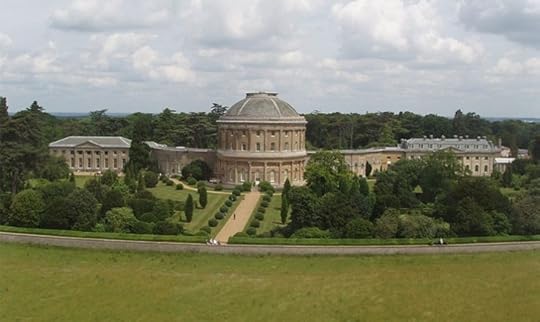
The West Wing at Ickworth House went uncompleted until 2006, when a joint partnership between the National Trust and Sodexo Prestige led to its renovation and opening as a centre for conferences and events. The first wedding in the property's history took place in 2006.
( John, 1st Earl of Bristol (1665-1751) )
( John Hervey, 2nd Baron Hervey (13 October 1696 – 5 August 1743) )
( Molly Lepel (1697 – 1768) )
( Hon. Frederick Augustus Hervey, 4th Earl of Bristol PC DD FRS (1 August 1730, Suffolk – 8 July 1803, Lazio) )
( Frederick William Hervey, 1st Marquess of Bristol (2 October 1769 – 15 February 1859) )
( Frederick William Hervey, 2nd Marquess of Bristol PC, FSA (15 July 1800 – 30 October 1864) )
( Frederick William John Hervey, 3rd Marquess of Bristol (28 June 1834 – 7 August 1907) )
( Rear-Admiral Frederick William Fane Hervey, 4th Marquess of Bristol (1863–1951) )
( Herbert Arthur Robert Hervey, 5th Marquess of Bristol (10 October 1870 – 5 April 1960) )
( Victor Frederick Cochrane Hervey, 6th Marquess of Bristol (6 October 1915 – 10 March 1985) )
( Frederick William John Augustus Hervey, 7th Marquess of Bristol (15 September 1954 – 10 January 1999) )
( Lord Frederick William Charles Nicholas Wentworth Hervey (26 November 1961–26 January 1998) )
( Frederick William Augustus Hervey, 8th Marquess of Bristol (born 19 October 1979) )
 comments
comments
House Stewards Flat Rotunda,
Bury Saint Edmunds IP29 5QE,
UK
Ickworth House is a country house near Bury St. Edmunds, Suffolk, England. It is a neoclassical building set in parkland. The house is in the care of the National Trust.
You can trace Ickworth’s origins back to the Domesday book when it was merely one of hundreds of assets belonging to the Abbey of Bury St Edmunds. Its association with the Hervey family began three centuries later in 1432, when Thomas Hervey acquired the land by marriage. Through success and scandal, Ickworth was the family’s home for the next 500 years. Thomas’ descendants set about transforming the ancient deer-park into an aristocratic paradise. The modest medieval hall became a turreted Tudor mansion. In 1701 the 1st Earl demolished the mansion and developed plans for an even grander abode. He also renovated the church, where all Ickworth’s owners have been laid to rest. Residents of the tiny hamlet of Ickworth were rehoused in neighbouring Horringer, and their former dwellings demolished to make way for pasture. The next generation of Herveys made even more of an impact on the landscape.
The house was built between 1795 and 1829. The building was the creation of Frederick Hervey, 4th Earl of Bristol and Bishop of Derry who commissioned the Italian architect Asprucci to design him a classical villa in the Suffolk countryside. The Earl died in 1803, leaving the completion of house to his successor.

In 1956, the house, park, and a large endowment were given to the National Trust in lieu of death duties. As part of the handover agreement, a 99-year lease on the 60-room East Wing was given to the Marquess of Bristol. However, in 1998 the 7th Marquess of Bristol sold the remaining lease on the East Wing to the National Trust. He was succeeded by his half-brother Frederick William Augustus Hervey, 8th Marquess of Bristol (born 19 October 1979). The National Trust refused to sell the remaining lease term back to the 8th Marquess, thereby contravening the Letter of Wishes which states that the head of the family should always be offered whatever accommodation he chooses at Ickworth.
The family's once private East Wing is now run as The Ickworth Hotel and apartments on a lease from the National Trust. The apartments are in Dower House which is in the grounds.

The West Wing at Ickworth House went uncompleted until 2006, when a joint partnership between the National Trust and Sodexo Prestige led to its renovation and opening as a centre for conferences and events. The first wedding in the property's history took place in 2006.
( John, 1st Earl of Bristol (1665-1751) )
( John Hervey, 2nd Baron Hervey (13 October 1696 – 5 August 1743) )
( Molly Lepel (1697 – 1768) )
( Hon. Frederick Augustus Hervey, 4th Earl of Bristol PC DD FRS (1 August 1730, Suffolk – 8 July 1803, Lazio) )
( Frederick William Hervey, 1st Marquess of Bristol (2 October 1769 – 15 February 1859) )
( Frederick William Hervey, 2nd Marquess of Bristol PC, FSA (15 July 1800 – 30 October 1864) )
( Frederick William John Hervey, 3rd Marquess of Bristol (28 June 1834 – 7 August 1907) )
( Rear-Admiral Frederick William Fane Hervey, 4th Marquess of Bristol (1863–1951) )
( Herbert Arthur Robert Hervey, 5th Marquess of Bristol (10 October 1870 – 5 April 1960) )
( Victor Frederick Cochrane Hervey, 6th Marquess of Bristol (6 October 1915 – 10 March 1985) )
( Frederick William John Augustus Hervey, 7th Marquess of Bristol (15 September 1954 – 10 January 1999) )
( Lord Frederick William Charles Nicholas Wentworth Hervey (26 November 1961–26 January 1998) )
( Frederick William Augustus Hervey, 8th Marquess of Bristol (born 19 October 1979) )
 comments
comments
Published on January 03, 2016 04:04
January 2, 2016
Queer Places: Palazzo del Bo
Address: Palazzo del Bo
Via 8 Febbraio 1848, 2,
35122 Padua PD
Italy
The University of Padua is a premier Italian university located in the city of Padua, Italy. The University of Padua was founded in 1222 as a school of law and was one of the most prominent universities in early modern Europe. It is among the earliest universities of the world and the second oldest in Italy. The University of Padua is one of Italy’s leading universities and ranks in the first position in all the recent ranking of Italian large universities. In 2010 the university had approximately 65,000 students and in 2013 was ranked "best university" among Italian institutions of higher education with more than 40,000 students.
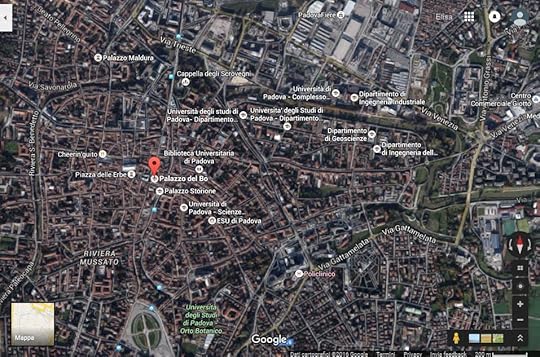
The University began teaching medicine in 1222. It played a leading role in the identification and treatment of diseases and ailments, specializing in autopsies and the inner workings of the body.
Since 1595, Padua's famous anatomical theatre drew artists and scientists studying the human body during public dissections. It is the oldest surviving permanent anatomical theatre in Europe. Anatomist Andreas Vesalius held the chair of Surgery and Anatomy (explicator chirurgiae) and in 1543 published his anatomical discoveries in De Humani Corporis Fabrica. The book triggered great public interest in dissections and caused many other European cities to establish anatomical theatres.
On 25 June 1678, Elena Lucrezia Cornaro Piscopia a Venetian noblewoman and mathematician became the first woman to be awarded a Doctor of Philosophy degree.
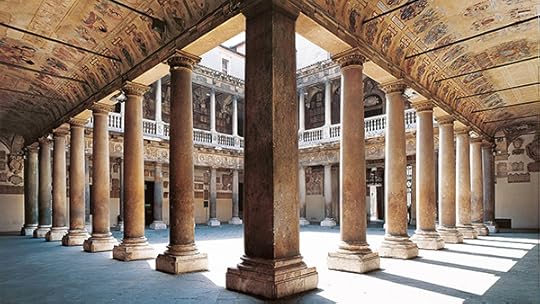
Il Bo
Both Sir John FInch and Sir Thomas Baines (buried in Christ's College, Cambridge: http://reviews-and-ramblings.dreamwid...) became doctors in medicine in Padua in 1657. FInch and Baines only mention one of their teachers at Padua and this was Molinetti, the Professor of Anatomy. In 1649 he succeeded Veslingius in the chair which had been occupied by Vesalius, Fallopius and Fabricius ab Aquapendente. In one of his note-books Finch copied out a Latin poem written by Baines in praise of this Venetian Molinetti. Baines refers to a "theatre", which is probably the one erected in Padua in 1593 by the Seigneury of Venice as a tribute to Fabricius, when thirty years of his professorship had passed.
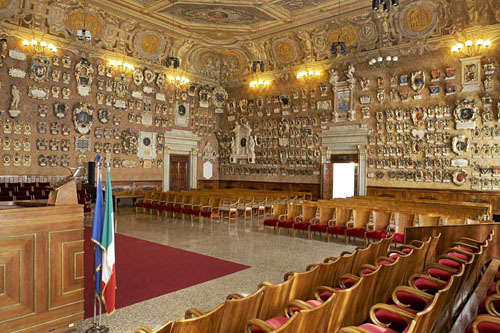
Aula Magna
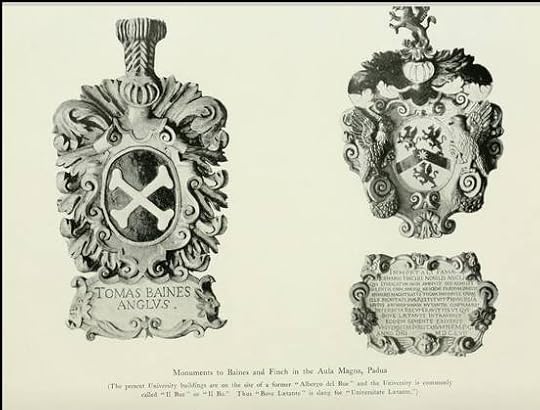
Finch was made Pro-Rector and Syndic of the University in 1656. Andrich gives an account of Finch's election and of the important events during his tenure of office, and we learn that young Finch was well thought by his contemporaries at Padua.
John Finch, Englishman, 1656-7
On the 1st of August 1656 Master John Finch, "having been elected without opposition, by the consent of all, and with great applause, remained viva voce Prorector and Syndic." On the 23rd of September the University senate, as Faciolati says, "ordered the Chancellors, that if anyone had obtained honours not by the consent of all the voters, but by the greater number only, commonly called "by majority," to declare this in the diploma, but they should give the diploma in a less decorated form, not on parchment but on paper." At the meeting on the 29th of September, there being present the Syndic and Counsellors, it was decreed that the registers (matriculate) should be given out to the students and the Counsellors of the nations should stand faith for each scholar. Wherefore from this year the Counsellors interceded for those who had matriculated (immatriculatio).
On the 7th November, when the Turks had been conquered, it was declared that a book in Latin or Italian should be written to congratulate the Venetian State, and on the 11th of December, that two scholars that had received honours from the Venetian college without payment, since they wished to be paid from the funds of the Gynnasium, should seek from the University that which by favour, but not by law, perhaps it was able to grant. There are two inscriptions dedicated to Finch in the Gynnasium. One in the entrance before the halls E and B with a wreath (stemmate) and monument; the other in hall A (the great hall) with a carved wreath in which he is described, by the decree of the Jurists of the University, as a most zelaous defender and restorer of the privileges of the scholars.

Teatro Anatomico
Prof. Darwin, who published a valuable paper "On monuments to Cambridge men in Padua" (http://archaeologydataservice.ac.uk/a...), gives a plate of the sculptured monument with inscription to Finch in the Aula Magna. Finch's arms were Argent a chevron between three gryphons passant sable, but here there is a mullet on the chevron, and the gryphons are falsely blazoned rampant. One of the three small monuments (all alike) to Baines in the Aula Magna is decipted also. Baines' arms were "sable two bones crosswise argent" (Gwillim) but here, as Prof. Darwin pointed out, the bones are placed saltirewise and really the arms of Newton are represented. Dr. Peile, later Master of Christ's College, very generously restored these monuments at his own expenses.
A letter written in 1657 to his sister Anne Conway describes how Finch and Baines took their degrees in the autumn of that year.
 comments
comments
Via 8 Febbraio 1848, 2,
35122 Padua PD
Italy
The University of Padua is a premier Italian university located in the city of Padua, Italy. The University of Padua was founded in 1222 as a school of law and was one of the most prominent universities in early modern Europe. It is among the earliest universities of the world and the second oldest in Italy. The University of Padua is one of Italy’s leading universities and ranks in the first position in all the recent ranking of Italian large universities. In 2010 the university had approximately 65,000 students and in 2013 was ranked "best university" among Italian institutions of higher education with more than 40,000 students.

The University began teaching medicine in 1222. It played a leading role in the identification and treatment of diseases and ailments, specializing in autopsies and the inner workings of the body.
Since 1595, Padua's famous anatomical theatre drew artists and scientists studying the human body during public dissections. It is the oldest surviving permanent anatomical theatre in Europe. Anatomist Andreas Vesalius held the chair of Surgery and Anatomy (explicator chirurgiae) and in 1543 published his anatomical discoveries in De Humani Corporis Fabrica. The book triggered great public interest in dissections and caused many other European cities to establish anatomical theatres.
On 25 June 1678, Elena Lucrezia Cornaro Piscopia a Venetian noblewoman and mathematician became the first woman to be awarded a Doctor of Philosophy degree.

Il Bo
Both Sir John FInch and Sir Thomas Baines (buried in Christ's College, Cambridge: http://reviews-and-ramblings.dreamwid...) became doctors in medicine in Padua in 1657. FInch and Baines only mention one of their teachers at Padua and this was Molinetti, the Professor of Anatomy. In 1649 he succeeded Veslingius in the chair which had been occupied by Vesalius, Fallopius and Fabricius ab Aquapendente. In one of his note-books Finch copied out a Latin poem written by Baines in praise of this Venetian Molinetti. Baines refers to a "theatre", which is probably the one erected in Padua in 1593 by the Seigneury of Venice as a tribute to Fabricius, when thirty years of his professorship had passed.

Aula Magna

Finch was made Pro-Rector and Syndic of the University in 1656. Andrich gives an account of Finch's election and of the important events during his tenure of office, and we learn that young Finch was well thought by his contemporaries at Padua.
John Finch, Englishman, 1656-7
On the 1st of August 1656 Master John Finch, "having been elected without opposition, by the consent of all, and with great applause, remained viva voce Prorector and Syndic." On the 23rd of September the University senate, as Faciolati says, "ordered the Chancellors, that if anyone had obtained honours not by the consent of all the voters, but by the greater number only, commonly called "by majority," to declare this in the diploma, but they should give the diploma in a less decorated form, not on parchment but on paper." At the meeting on the 29th of September, there being present the Syndic and Counsellors, it was decreed that the registers (matriculate) should be given out to the students and the Counsellors of the nations should stand faith for each scholar. Wherefore from this year the Counsellors interceded for those who had matriculated (immatriculatio).
On the 7th November, when the Turks had been conquered, it was declared that a book in Latin or Italian should be written to congratulate the Venetian State, and on the 11th of December, that two scholars that had received honours from the Venetian college without payment, since they wished to be paid from the funds of the Gynnasium, should seek from the University that which by favour, but not by law, perhaps it was able to grant. There are two inscriptions dedicated to Finch in the Gynnasium. One in the entrance before the halls E and B with a wreath (stemmate) and monument; the other in hall A (the great hall) with a carved wreath in which he is described, by the decree of the Jurists of the University, as a most zelaous defender and restorer of the privileges of the scholars.

Teatro Anatomico
Prof. Darwin, who published a valuable paper "On monuments to Cambridge men in Padua" (http://archaeologydataservice.ac.uk/a...), gives a plate of the sculptured monument with inscription to Finch in the Aula Magna. Finch's arms were Argent a chevron between three gryphons passant sable, but here there is a mullet on the chevron, and the gryphons are falsely blazoned rampant. One of the three small monuments (all alike) to Baines in the Aula Magna is decipted also. Baines' arms were "sable two bones crosswise argent" (Gwillim) but here, as Prof. Darwin pointed out, the bones are placed saltirewise and really the arms of Newton are represented. Dr. Peile, later Master of Christ's College, very generously restored these monuments at his own expenses.
A letter written in 1657 to his sister Anne Conway describes how Finch and Baines took their degrees in the autumn of that year.
 comments
comments
Published on January 02, 2016 11:26
January 1, 2016
Queer Places: Christ's College, Cambridge
Address: Christ's College,
St Andrew's St,
Cambridge CB2 3BU,
UK
Christ's College is a constituent college of the University of Cambridge. The college includes the Master, the Fellows of the College, and about 450 undergraduate and 170 graduate students. The college was founded by Lady Margaret Beaufort in 1505, its royal charter granted on 1 May of that year, and was the twelfth of the Cambridge colleges to be founded in its current form. It was originally established as God's House in 1437. The college is renowned for educating some of Cambridge's most famous alumni, including Charles Darwin and John Milton.

Within Cambridge, Christ's has a reputation for strong academic performance and tutorial support. It has averaged 1st place on the Tompkins Table from 1980–2006 and third place from 2006 to 2013.
Sir John Finch (1626–1682) was ambassador of England to the Ottoman Empire. He was the younger brother of Lord Chancellor Sir Heneage Finch, 1st Earl of Nottingham; their half-sister was the philosopher Lady Anne Conway of Ragley Hall. Anne and John Finch were pupils of Henry More. After Eton John Finch studied with More at Christ's College, Cambridge, and there met his lifelong companion Sir Thomas Baines. "The Book of Study Rents shows they were joint occupants of the "second upper chamber" in the "southermost" staircase of the New Building, and Finch's arms are to be seen to this day in a finely oak-panelled room of the New, or Fellows, Building" (Finch and Baines, A Seventeenth Century Friendship, by Archibald Malloch, 1917)
Following a Grand Tour of Italy, where they graduated in medicine from the University of Padua in 1656 Finch and Baines returned to Christ's as teachers in 1660, and fellows of the Royal Society.
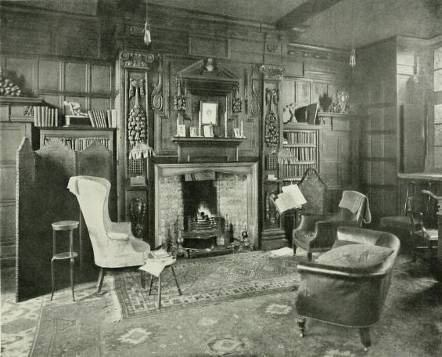
Rooms of Finch and Baines at Fellows' Building
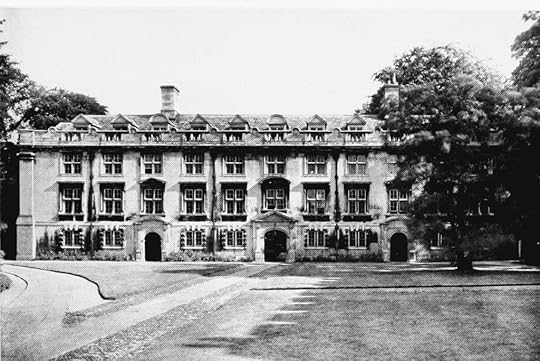
Christ's College. Fellows' Building, from W. 1640–45

Fellows' Building. Room on first floor, staircase 'A'. Panelling 1642–45

Entrance Court. S. range. Room on first floor, staircase 'G'. Panelling c. 1600
Sir John was ambassador to the Sublime Porte of the Ottoman Empire in Constantinople, succeeding his uncle Heneage Finch, 3rd Earl of Winchilsea and his cousin Daniel Harvey arriving on 18 March 1674. Baines died in Constantinople on September 5, 1680.
( A letter from John Finch to his brother Heneage )
Finch buried Baines’s innards under a memorial which referred to their "wonderful, devoted friendship" and their "beautiful and unbroken marriage of souls and inseparable companionship of thirty-six whole years" and "sacred to an unspeakable love." The rest of his body he embalmed, brought back to England, and buried at Christ’s.
( Epetaph on Sir Thomas Baines his Bowells inter'd att Constantinople made by Sir John Finch, 1682 )

( Epitaph in Latin to their joint memories by Henry More )


Sir John Finch died of pleurisy in Florence, Italy on November 18, 1682, and is buried in Christ's College and commemorated with Baines, with an elaborate monument. Also Henry More (b. Oct. 12, 1614 d. Sep. 1, 1687) is interred in Christ's College Chapel. The monument by Joseph Catterns of London was erected in the Chapel and stands between the organ chamber and the altar. The expenses were met by Daniel the 2nd Earl of Nottingham and the monument was not completed before 1684. The pedestals bear a bust of Sir John Finch and Sir Thomas Baines and there is a long inscription composed by Henry More, who outlived his pupils by some years. The bodies are buried in front of the tomb and within the altar rails. Finch and Baines have been further remembered at Christ's College. In 1882 they were among those chosen as "glass worthies" for two of the twenty-one lights of the west oriel window in the Hall, depicting the founders, benefactors and worthies of the College.
Their portraits by Florentine artist Carlo Dolci hang in the Fitzwilliam Museum, Cambridge.
Read online: https://archive.org/stream/finchbaine... Finch and Baines, A Seventeenth Century Friendship, by Archibald Malloch, 1917
 comments
comments
St Andrew's St,
Cambridge CB2 3BU,
UK
Christ's College is a constituent college of the University of Cambridge. The college includes the Master, the Fellows of the College, and about 450 undergraduate and 170 graduate students. The college was founded by Lady Margaret Beaufort in 1505, its royal charter granted on 1 May of that year, and was the twelfth of the Cambridge colleges to be founded in its current form. It was originally established as God's House in 1437. The college is renowned for educating some of Cambridge's most famous alumni, including Charles Darwin and John Milton.

Within Cambridge, Christ's has a reputation for strong academic performance and tutorial support. It has averaged 1st place on the Tompkins Table from 1980–2006 and third place from 2006 to 2013.
Sir John Finch (1626–1682) was ambassador of England to the Ottoman Empire. He was the younger brother of Lord Chancellor Sir Heneage Finch, 1st Earl of Nottingham; their half-sister was the philosopher Lady Anne Conway of Ragley Hall. Anne and John Finch were pupils of Henry More. After Eton John Finch studied with More at Christ's College, Cambridge, and there met his lifelong companion Sir Thomas Baines. "The Book of Study Rents shows they were joint occupants of the "second upper chamber" in the "southermost" staircase of the New Building, and Finch's arms are to be seen to this day in a finely oak-panelled room of the New, or Fellows, Building" (Finch and Baines, A Seventeenth Century Friendship, by Archibald Malloch, 1917)
Following a Grand Tour of Italy, where they graduated in medicine from the University of Padua in 1656 Finch and Baines returned to Christ's as teachers in 1660, and fellows of the Royal Society.

Rooms of Finch and Baines at Fellows' Building

Christ's College. Fellows' Building, from W. 1640–45

Fellows' Building. Room on first floor, staircase 'A'. Panelling 1642–45

Entrance Court. S. range. Room on first floor, staircase 'G'. Panelling c. 1600
Sir John was ambassador to the Sublime Porte of the Ottoman Empire in Constantinople, succeeding his uncle Heneage Finch, 3rd Earl of Winchilsea and his cousin Daniel Harvey arriving on 18 March 1674. Baines died in Constantinople on September 5, 1680.
( A letter from John Finch to his brother Heneage )
Finch buried Baines’s innards under a memorial which referred to their "wonderful, devoted friendship" and their "beautiful and unbroken marriage of souls and inseparable companionship of thirty-six whole years" and "sacred to an unspeakable love." The rest of his body he embalmed, brought back to England, and buried at Christ’s.
( Epetaph on Sir Thomas Baines his Bowells inter'd att Constantinople made by Sir John Finch, 1682 )

( Epitaph in Latin to their joint memories by Henry More )


Sir John Finch died of pleurisy in Florence, Italy on November 18, 1682, and is buried in Christ's College and commemorated with Baines, with an elaborate monument. Also Henry More (b. Oct. 12, 1614 d. Sep. 1, 1687) is interred in Christ's College Chapel. The monument by Joseph Catterns of London was erected in the Chapel and stands between the organ chamber and the altar. The expenses were met by Daniel the 2nd Earl of Nottingham and the monument was not completed before 1684. The pedestals bear a bust of Sir John Finch and Sir Thomas Baines and there is a long inscription composed by Henry More, who outlived his pupils by some years. The bodies are buried in front of the tomb and within the altar rails. Finch and Baines have been further remembered at Christ's College. In 1882 they were among those chosen as "glass worthies" for two of the twenty-one lights of the west oriel window in the Hall, depicting the founders, benefactors and worthies of the College.
Their portraits by Florentine artist Carlo Dolci hang in the Fitzwilliam Museum, Cambridge.
Read online: https://archive.org/stream/finchbaine... Finch and Baines, A Seventeenth Century Friendship, by Archibald Malloch, 1917
 comments
comments
Published on January 01, 2016 04:54
December 30, 2015
Queer Places: Abbaye de Fleury
Address: Abbaye de Fleury,
45730 Saint-Benoît-sur-Loire,
France
Fleury Abbey (Floriacum) in Saint-Benoît-sur-Loire, Loiret, France, founded about 640, is one of the most celebrated Benedictine monasteries of Western Europe, which possesses the relics of St. Benedict of Nursia. Its site on the banks of the Loire has always made it easily accessible from Orléans, a center of culture unbroken since Roman times. Today the abbey has over forty monks and is headed by the abbot Etienne Ricaud.
Abbo of Fleury (died 1004) a monk and abbot of Fleury was a theologian of wide-ranging intellect; his life was written by the chronicler Aimoin, also a monk of Fleury. Andrew of Fleury (writing c 1043) wrote Miracula sancti Benedicti. Hugh of Fleury (died after 1118) was a monk of Fleury known for his chronicles and other writings.
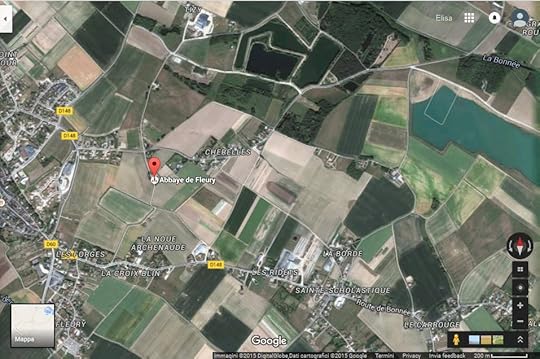
The choir of the church contains the tomb of a French monarch, Philip I of France, buried there in 1108.
Philip I of France (May 23, 1052, Champagne-et-Fontaine, Departement de la Dordogne, Aquitaine, France - Jul. 29, 1108, Melun, Departement de Seine-et-Marne, Île-de-France, France), capetian King of the Franks or Francia, King of France, Philip I of France, Philip the the Amorous. Son of Henry I, King of the Franks and Anne of Kiev, Grandson of Robert II, King of the Franks and Constance or Arles, Yaroslav I the Wise, Grand Prince of Kiev and Ingegerd Olofsdotter of Sweden. Philip was the husband of Bertha, the daughter of Floris I, Count of Holland and Gertrude of Saxony, daughter of Bernard II, Duke of Saxony. They married in 1072 and produced five children: Constance, wife of Hugh of Champagne & Bohemund of Antioch; Louis VI, King of the Franks; Henry b 1083, died young; Charles b 1085; Odo 1087-1096.
Philip repudiated Bertha based on the fact she was too fat, and married a lady he had fallen in love with, Bertrade de Montfort, the daughter of Simon I de Montfort and Agnes, Countess of Evreux, and the wife of Count Fulk IV of Anjou. They were married 15 May 1092, even though they both had living spouses, and had three children: Philip, Count of Mantes; Fleury, Seigneur of Nangis; Cecile of France, wife of Tancred, Prince of Galilee & Pons of Tripoli.

« Saint-Benoît -France » par Gilbertus — Travail personnel. Sous licence CC BY-SA 3.0 via Wikimedia Commons .
Despite being French, a Frank, and a Capetian line dating back to the Carolingians, Philip's mother chose a Greek name for her son. Phillip, as his ancestors, ruled for an unusual length of time for his era.
Philip's father died in 1060 when Philip was still a youth, and crowned at the age of seven. His mother acted as regent as the first Frankish queen, until he was fourteen. Baldwin VI of Flanders assisted her in her duties until he died in 1070, at which point Flanders was taken by Robert Frisian. Baldwin's wife received help from Philip who defeated Robert at the Battle of Cassel in 1071.
Philip was excommunicated in 1094 by Hugh, the Archbishop of Lyon, and again by Pope Urban II in 1095 for his second marriage.
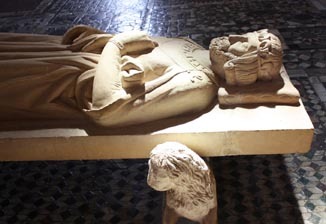
Phillip made peace with William the Conqueror in 1077, allowing Phillip to annex Vexin, and take Bourges in 1100. When the role started for the First Crusade, Phillip refrained due to his conflicts with the pope over his wife, and sent his brother, Hugh of Vermandois in his stead.
Phillip died at the castle of Meulan, and at his request, was buried at the monastery of Saint-Benoît-sur-Loire – instead of at St Denis with his ancestors. Phillip was succeeded by his son, Louis VI, but not without other contestants.
On March 1, 1098, King Philip I consecrated Jean, bishop of Orleans. Jean had been the lover of Phillip, and was at the time, lover of Raoul II, Archibishop of Tours (from 1986 to 1117). Jean ruled as bishop for almost forty years, and Raoul and him continued to be well known and respected.
 comments
comments
45730 Saint-Benoît-sur-Loire,
France
Fleury Abbey (Floriacum) in Saint-Benoît-sur-Loire, Loiret, France, founded about 640, is one of the most celebrated Benedictine monasteries of Western Europe, which possesses the relics of St. Benedict of Nursia. Its site on the banks of the Loire has always made it easily accessible from Orléans, a center of culture unbroken since Roman times. Today the abbey has over forty monks and is headed by the abbot Etienne Ricaud.
Abbo of Fleury (died 1004) a monk and abbot of Fleury was a theologian of wide-ranging intellect; his life was written by the chronicler Aimoin, also a monk of Fleury. Andrew of Fleury (writing c 1043) wrote Miracula sancti Benedicti. Hugh of Fleury (died after 1118) was a monk of Fleury known for his chronicles and other writings.

The choir of the church contains the tomb of a French monarch, Philip I of France, buried there in 1108.
Philip I of France (May 23, 1052, Champagne-et-Fontaine, Departement de la Dordogne, Aquitaine, France - Jul. 29, 1108, Melun, Departement de Seine-et-Marne, Île-de-France, France), capetian King of the Franks or Francia, King of France, Philip I of France, Philip the the Amorous. Son of Henry I, King of the Franks and Anne of Kiev, Grandson of Robert II, King of the Franks and Constance or Arles, Yaroslav I the Wise, Grand Prince of Kiev and Ingegerd Olofsdotter of Sweden. Philip was the husband of Bertha, the daughter of Floris I, Count of Holland and Gertrude of Saxony, daughter of Bernard II, Duke of Saxony. They married in 1072 and produced five children: Constance, wife of Hugh of Champagne & Bohemund of Antioch; Louis VI, King of the Franks; Henry b 1083, died young; Charles b 1085; Odo 1087-1096.
Philip repudiated Bertha based on the fact she was too fat, and married a lady he had fallen in love with, Bertrade de Montfort, the daughter of Simon I de Montfort and Agnes, Countess of Evreux, and the wife of Count Fulk IV of Anjou. They were married 15 May 1092, even though they both had living spouses, and had three children: Philip, Count of Mantes; Fleury, Seigneur of Nangis; Cecile of France, wife of Tancred, Prince of Galilee & Pons of Tripoli.

« Saint-Benoît -France » par Gilbertus — Travail personnel. Sous licence CC BY-SA 3.0 via Wikimedia Commons .
Despite being French, a Frank, and a Capetian line dating back to the Carolingians, Philip's mother chose a Greek name for her son. Phillip, as his ancestors, ruled for an unusual length of time for his era.
Philip's father died in 1060 when Philip was still a youth, and crowned at the age of seven. His mother acted as regent as the first Frankish queen, until he was fourteen. Baldwin VI of Flanders assisted her in her duties until he died in 1070, at which point Flanders was taken by Robert Frisian. Baldwin's wife received help from Philip who defeated Robert at the Battle of Cassel in 1071.
Philip was excommunicated in 1094 by Hugh, the Archbishop of Lyon, and again by Pope Urban II in 1095 for his second marriage.

Phillip made peace with William the Conqueror in 1077, allowing Phillip to annex Vexin, and take Bourges in 1100. When the role started for the First Crusade, Phillip refrained due to his conflicts with the pope over his wife, and sent his brother, Hugh of Vermandois in his stead.
Phillip died at the castle of Meulan, and at his request, was buried at the monastery of Saint-Benoît-sur-Loire – instead of at St Denis with his ancestors. Phillip was succeeded by his son, Louis VI, but not without other contestants.
On March 1, 1098, King Philip I consecrated Jean, bishop of Orleans. Jean had been the lover of Phillip, and was at the time, lover of Raoul II, Archibishop of Tours (from 1986 to 1117). Jean ruled as bishop for almost forty years, and Raoul and him continued to be well known and respected.
 comments
comments
Published on December 30, 2015 01:58
Book Blast: The Sky People Trilogy by DC Juris
 The Sky People Trilogy by DC Juris
The Sky People Trilogy by DC JurisPublisher: http://www.torquerebooks.com/index.ph...
Blurb: Driven by visions of his soul mate, Tristan, Jinsu steps through the portal to Earth, leaving all he has ever known behind.. Seven months into their fairy-tale romance, and Tristan and Jinsu couldn't be happier. But when Jinsu falls ill with a mysterious, lingering condition, everything changes. Jinsu's magic is dying and taking him with it. Suddenly the couple's desire to find a way back to Jinsu's home world is more than just a dream–it's a necessity. With Jinsu's time quickly running out, Tristan is forced to seek help from someone he'd hoped to never, ever lay eyes on again.
Tristan awakens on Torottu, but the portal wasn't meant for humans, and he's been near death since his arrival almost ten months ago. Even worse, Jinsu has no idea who Tristan is—the return trip through the portal erased his memory of Earth, of their relationship, or Tristan himself. Winning Jinsu's heart again won't be easy, especially if Kelan, Jinsu's twin, has anything to say about it. Kelan loves Jinsu, too, and he won't be put aside for Tristan. Not again. Tristan knows his only chance for happiness—and the only chance for Jinsu and Kelan—is to follow his heart. Previously published by Breathless Press.
( Excerpt )

 Meet the author: Romance author, sic-fi fan club Captain, cosplayer, reigning Queen of Monkeyland, and random menace. Yep, we're talking about DC Juris. She’s a cupcake making, football watching, rubber duck collecting, drag show loving, full of fabulous with a Capital F kinda gal. She's also an Ordained Minister and an amateur photographer. She lives in Upstate NY with her husband, three dogs, and three cats. When she's not writing, you can find her in her favorite chair watching "Star Trek" and "Supernatural" repeats on Netflix, or surfing the web for porn. Er...research. Surfing the web for research. She may speak softly but she lives and loves loudly. Just ask the neighbors. ::wink::
Meet the author: Romance author, sic-fi fan club Captain, cosplayer, reigning Queen of Monkeyland, and random menace. Yep, we're talking about DC Juris. She’s a cupcake making, football watching, rubber duck collecting, drag show loving, full of fabulous with a Capital F kinda gal. She's also an Ordained Minister and an amateur photographer. She lives in Upstate NY with her husband, three dogs, and three cats. When she's not writing, you can find her in her favorite chair watching "Star Trek" and "Supernatural" repeats on Netflix, or surfing the web for porn. Er...research. Surfing the web for research. She may speak softly but she lives and loves loudly. Just ask the neighbors. ::wink::Where to find the author:
Facebook Author Page: www.facebook.com/danielchristianjuris
Twitter: www.twitter.com/dcjuris
Other: http://dcjuris.blogspot.com

Tour Dates & Stops: December 30, 2015
Parker Williams, A.M. Leibowitz, The Hat Party, Bayou Book Junkie, Scattered Thoughts & Rogue Words, BFD Book Blog, Wicked Faerie's Tales and Reviews, Charley Descoteaux, Elisa - My Reviews and Ramblings, Molly Lolly, Nephy Hart, MM Good Book Reviews, Inked Rainbow Reads, Andrew Q. Gordon, Velvet Panic
Rafflecopter Prize: E-copy of ‘The Sky People Trilogy’
Rafflecopter Code:
a Rafflecopter giveaway

 comments
comments
Published on December 30, 2015 01:11



